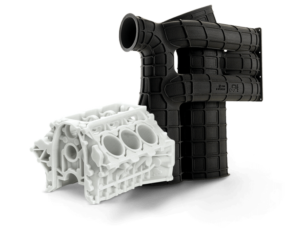The medical product sector is intensely competitive, with billions of dollars at stake. As chronic diseases become more prevalent and populations age, there is an escalating demand for devices that support disease prevention, diagnosis, treatment, monitoring, rehabilitation, and palliation. This surge in chronic conditions has also sparked consumer interest in home-based solutions, broadening the market for wearable and other health monitoring technologies, such as continuous glucose monitors for non-diabetics and other biotechnological devices. Companies are pouring substantial resources into research and development (R&D) to address these growing needs, making the time to market critical. The choice of manufacturing methods can significantly impact product development and market readiness. Quick Molded Parts can accelerate the development cycle and reduce costs, all while maintaining high-quality standards.
As a First Prototype Part
Taking a product from concept through market availability requires a large investment in time, money, and resources. It must also be safe and function as intended for the duration intended. There is a lot at risk for medical device manufacturers if the project fails or the device fails. This risk makes prototyping in medical device manufacturing essential. It serves as a bridge between conceptual design and full-scale production, offering an evaluation of the product’s functionality, design, user interaction, and overall feasibility. However, Quick Molded parts, as a prelude to prototyping, allow device manufacturers to identify issues with device design or manufacturability early on, saving time and money.
While prototyping a device adds upfront costs, the project’s total cost can be lower when the initial prototype is done as Quick Molded Parts before moving into full prototyping. The further upstream an issue is found, the more expensive it becomes to fix it. Quick Molded Parts allows you to work out challenges before you begin manufacturing the product.
As A Small Run
Sometimes, manufacturers need multiple versions of a part or want to try it in a limited market before rolling out large-scale production. Whatever the reason a short run of products is needed, Quick Molded Parts allows you to get production quality products in your hands quickly.
The Value of Quick Molded Parts
Quick Molded Parts uses standard injection molding equipment but streamlines the process for rapid turnaround. This method uses aluminum molds, which are not only quicker to produce but also more cost-effective and provide these key benefits:
- Speed – As the name suggests, Quick Molded Parts significantly speeds up the development process. It allows engineers and designers to quickly produce physical models to evaluate for form, fit, and function.
- Cost-Efficiency – Using aluminum tools reduces both the lead time and the costs associated with mold production, making it feasible to have parts shipped within a week. It also allows product designers to uncover design flaws before making significant investments.
- Ideal for Initial Prototypes and Small Batches – Capable of producing up to 250 parts, this method is perfect for initial prototypes and limited production runs, allowing the part to be evaluated in actual production-grade materials.
- Material and Functional Testing – Quick Molded Parts allows developers to test various materials (from 15 in stock) and assess their functional performance in actual use conditions. It is essential to ensure the device’s reliability and safety before it enters mass production.
- Run Different Iteration – Quick Molded Parts facilitates the easy iteration of designs. Based on testing and feedback, modifications can be made quickly to parts, which is crucial in the highly competitive field of medical product manufacturing.
- Ideal for Smaller Parts – Quick molded parts are advantageous for small and simple parts – a maximum of 80mm x 80mm x 50mm (3 in x 3 in x 2 in); however, the designs cannot incorporate complex features such as sliders or lifters.
- Communication – A physical model can improve communication within a development team or with stakeholders (such as investors or regulatory bodies), as it is easier to evaluate a tangible object than conceptual drawings.
Quick Molded Parts are invaluable for medical device companies looking to run first prototype parts using real production grade material or conduct small-scale production runs. Their quick turnaround helps hasten the design validation and regulatory approval processes, significantly speeding up the time to market.
Get to Market Faster With Quickparts
Quickparts can take on your injection molding needs, no matter how complex. With three levels of service (Quick Molded Parts, full Prototyping, and Production), we can take you quickly from concept to production.
Quick Molded Parts
- Ships: within one week
- Tool life: 250 parts
- Material: Parts in production-grade material
- Design/geometry: Some limitations
- Max. part size: 80 x 80 x 50mm
- Materials: Over 15 materials in stock
Prototyping
- Ships: 2 – 6 weeks after PEG approval
- Tool life: 2,500 parts
- Material: Parts in real production-grade material
- Design/geometry: No limitations
- Max. part size: 500 x 500 x 100 mm
- Guaranteed tool accuracy
Production
- Ships: 4 – 8 weeks after PEG approval
- Quality: Custom Quality Inspections and Standards
- Tool life: 10,000 to millions of parts
- Materials: Parts in production-grade materials; the customer can supply materials
- Max. Part size: 1500 x 1000 x 350mm
- Accuracy: Guaranteed part accuracy
Are you ready to streamline your development process and enhance your market competitiveness with Quick Molded Parts? Contact us today to learn how our tailored injection molding solutions can shorten your time to market, ensure product safety, and reduce developmental costs. We can help you transform your medical device concept into a market-ready reality faster than ever.


